Digital image processing
Raoul BehrendGeneva Observatory
CH-1290 Sauverny - Switzerland
Raoul.Behrend@unige.ch
My hobbies: celestrial mechanics, astrometry, earth satellites, aso. The corresponding programs I wrote are Aplaxxxx (complete offset-dark-flat treatement of ccd's frames - coming soon as a stampware (freeware registered by a beautyful stamped postcard <;3)~~~~)), BifsConv, Carte, Eph, Nifflo, Photo, MiniMir, DetOrb, SatJup, CourbRot, RotaRap, and others. They are made for personnal computer (PC). A very nice application of DetOrb was the determination of the scale of the solar system using the parallax of the asteroid 2000 QW7: 8.796±0.003" (document in french only).
Here are some pictures from my image processor BIFSxx. The left parts are original images and the right parts represent the results. The 48 supported formats are derived from the following families: bmp, imq (spaceprobes, with or without Huffman's compression), ibg, fit (fits, 1-, 2- and 4-bytes integers, 8-bytes reals), st* (st4, st4x, st5, st6, st7, st8, st9, stx, pixcel, with or without compression), cpa (~15 bits, with or without compression), t1m, arn, pds (and vicar), per (Titus format of satellite images), img, ccd, raw, pic, tif (tiff, 8 and 16 bits, uncompressed), mx5, hx5, xl8, gif, pcx, imi (TMSat satellite).
To limit the bandwidth, this document's images are the shortest files from jpg and png. The other better pictures can be accessed with a simple click.

Deconvolution and elimination of interferences.
Turbulences on the surface of Jupiter. The dark current and flat field were not taken into account; this explain the embossed shape. Origin: Voyager probe.

Deconvolution and elimination of interferences.
Io. Origin: Voyager probe.
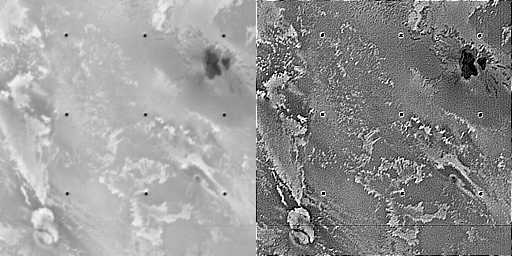
Deconvolution and elimination of interferences.
Io's surface. Origin: Voyager probe.

Deconvolution and elimination of interferences.
Europe. Origin: Voyager probe.

Deconvolution and elimination of interferences.
Ganymed. Origin: Voyager probe.

Deconvolution and elimination of interferences.
Callisto. Origin: Voyager probe.
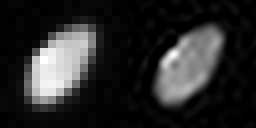
Zoom, deconvolution and elimination of interferences.
Amalthea. Origin: Voyager probe.

Deconvolution and elimination of interferences.
Titan's atmosphere. Origin: Voyager 1 probe.

Histogram adaptation after deconvolution and elimination of interferences.
Saturn's rings. Origin:Voyager probe.
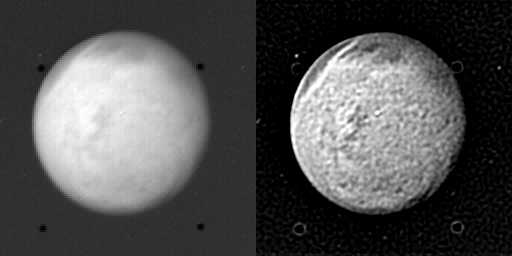
Zoom, deconvolution and elimination of interferences.
Triton. Origin: Voyager 2 probe.

Deconvolution.
Sun's surface in alpha-band of hydrogen. Origin: the st4 of Armin Behrend.

Deconvolution.
Sun spot. Origin: the st4 of Armin Behrend.
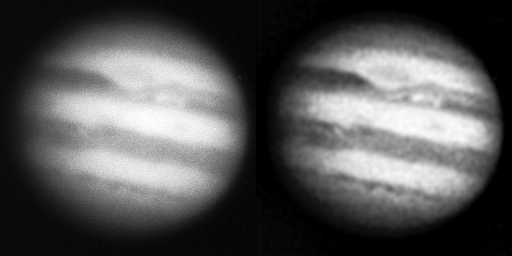
Deconvolution.
Jupiter. Origin: negative film by Armin Behrend.
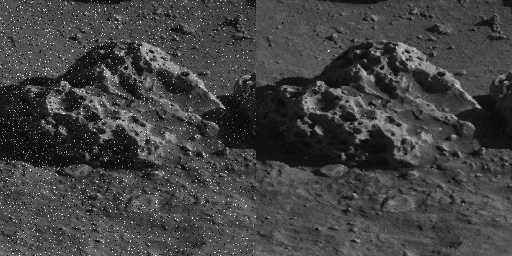
Parasits removal.
Mars' ground. Origin: Viking probe.

Deconvolution (non final version).
Mars: composit of twenty images. Origin: the StarLight Xpress HX516 camera of Martino Nicolini, at Cavezzo Observatory.

Deconvolution.
Craters on the moon. Origin: sample image of the SBIG's st4.
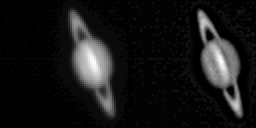
Zoom and deconvolution.
Saturne. Origine: la st4 de Michel Mollard.
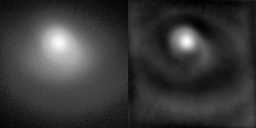
Deconvolution.
Nucleus and jets of the comet Hale-Bopp. Origin: André Blécha. Remark: the telescope was in construction and the mirror not yet recovered with aluminium; that's why the quality is not very high.

Deconvolution after sampling of the point spread function.
Unguided erratic motion of the telescope. Origin: negative film by Raphaël Jubin.
No corrections of non-linearities were made; original image in jpg format.
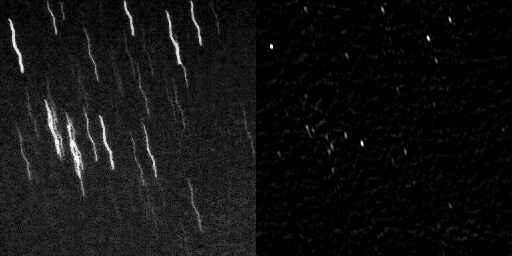
Deconvolution after sampling of the point spread function.
Unguided erratic motion of the telescope. Origin: negative film by Raphaël Jubin.
No corrections of non-linearities were made; original image in jpg format.


Deconvolution after sampling of the point spread function. Right: detail of the double star.
Unguided erratic motion of the telescope. Origin: Matthieu Conjat's ST4.

Deconvolution of three R G and B images. Origin: the st7 of Richard Jacobs.
The trichromic recombination is (fastly) made with Gimp, a PaintShopPro like program...

Deconvolution and elimination of interferences.
SanFrancisco's Bay seen by the TMSat satellite and operated by the Thai MicroSatellite Company Ltd and the Surrey Satellite Technology Ltd. The ccd image is raw, non processed for the sensivity of each column; that explains the horizontal lines.

Deconvolution.
Grand Canyon seen by the UOSat-12 satellite operated by the Surrey Satellite Technology Ltd.
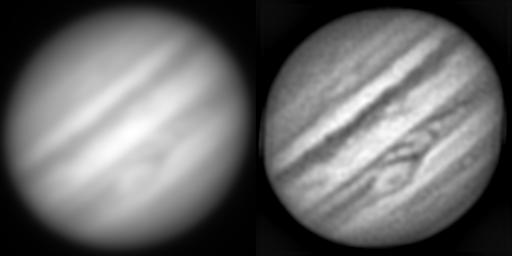
Deconvolution. Image of Jupiter taken by Bastien Confino, at OFXB-StLuc.

Deconvolution. Image of Jupiter taken by Bastien Confino, at OFXB-StLuc.
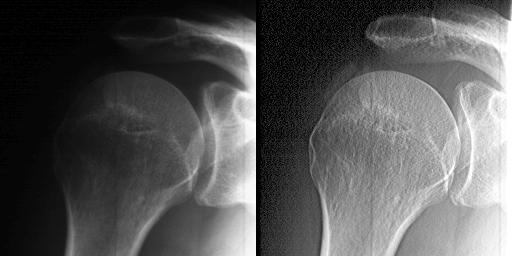
Local adaptation of contrast and binning of pixels. Calcifying supraspinatus tendinitis in the context of a shoulder periarthritis. (Medical informations related to this picture: DrABiz). Radiographic material kindly loaned by Sion Hospital and scanned at Geneva Observatory. Grace to the binning, the pixels issued by the 8-bits scanner are transformed to ~12-bits metapixels.
More informations:
- You may post here all kind of images to test with BIFSxx, even in less common formats. Please avoid the loosy jpg and immoral images! Don't preprocess nonlinearities (for example histogram and gamma corrections, except for film); dark current, zero level and flat field are warmly encouraged for ccd images. The best results will be shown here.
- The raw images of Voyagers and Vikings probes are kindly supplied by NASA/JPL/CalTech as cidirom.
- The processed and raw images wih no indication of origin are ©OMG. No reproduction without my preliminary agreement.
Some links:
- My personnal homepage
- ftp zone: some files and programs, depending on mood. Actually:
- SatJup, a small simulator of galilean moons.
- St42Bmp, a st4 to bmp converter.
- BifsConv, a converter from many formats (bmp, imq, st4, stx, ima, cpa, pic, tif, gif, mx5, hx5, xl8, dat, pcx, per, dib, arn, blu, bb1, bb2, bb3, bb4, grn, irq, ibg, img, ir1, ir2, ir3, n07, n15, pds, red, sgr, sur, sun, vio, fts, 08b, raw, sbi, st5, st6, st7, st8, st9, 237, imi, ccd) to fit. The complete description is available here.
- The Tle.New file which gives orbital elements of visual (by naked eyes) satellites in real Tle format is directly «pumped» from T.S. Kelso's site. An other very good source for TLEs is the site of Mike McCants.
- The TleSort.Sat and Oldies.Sat files form a database of earth artificial satellites orbital elements, they are also compressed by GZip. The format is near to the ordinary Tle's, but it's possible that they are not recognized by other programs than MiniMir (demos: DemoMir1 and DemoMir2).
- TleSort.zip contains all files needed to execute TleSort. Options for TleSort are:
- /L sort by launch
- /C sort in reverse order
- /L0 delete line 0 which may be uncompatible with some software
- Miam-Globs' homepage
- Richard Jacobs' homepage
- Michel Mollard's homepage
- Matthieu Conjat's homepage
- André Blécha's homepage
- Cavezzo Observatory's homepage
- OFXB-StLuc's homepage
- Geneva Observatory's welcome page
- AstroInfo (no more speaks french !!!)
来源:http://obswww.unige.ch/~behrend/page_mgo.html



























 932
932

 被折叠的 条评论
为什么被折叠?
被折叠的 条评论
为什么被折叠?








